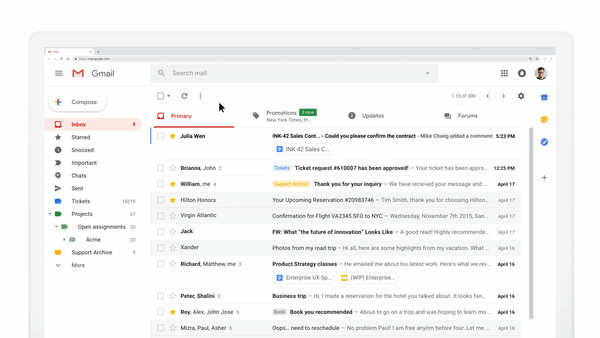Gmail has just launched a new feature: dynamic emails. This new feature, described in a Google blog post, introduces a subtle innovation that contributes a little more to the creation of an ecosystem from which we cannot leave. Under the guise of improving the Google user experience and its multiple subsidiaries seek to keep users captive at all costs. Explanations in today’s article and feedback on the featured snippets introduced by the search engine in 2014.

This is how gmail dynamic email works
Dynamic emails
An image is sometimes better than a long explanation. An animated gif “made by Google” illustrates the use of dynamic emails through a use case on Pinterest. From now on it will be possible to “pin” pins directly from the email. The other instances of use cited by Google are as follows:
- fill in a form: no need to go to a website to fill in the form details. Now it is possible to do it directly in the body of the email
- choose a time slot: thanks to the integration with doodle you no longer need to go to the site to select the time slots that suit you
- consult a product catalogue: this case of use is likely to be the most common. It becomes possible to browse a catalogue (of products but also of images in the light of what is done for Pinterest) directly in the body of the email. No need to go to the sender’s website anymore, even if it is easy to imagine that it will always be more comfortable to browse a product catalogue on a regular website rather than in a window reduced to the size of an email.
Thanks to dynamic emails, the user no longer needs to “exit” Gmail. If the user experience is improved; as a result, it is also worth considering the role of this innovation in the broader context of Google’s strategy. And this strategy became evident with the launch of featured snippets in 2014.
Wikipedia traffic has dropped by 21% with the introduction of “featured snippets”
The “rank 0” (the “featured snippets”) is the first step towards a closed ecosystem
The featured snippets are a feature introduced by Google in 2016 in France and from September 2014 in the United States. They allow you to highlight the response to a query directly in the search page above the search engine results. This favourable position, above all, has given rise to the concept of “rank 0”, that is to say, this pre-eminent position in search results.
It is, of course, convenient for the Internet user who asks himself a question to see the answer appear directly. No need to get lost on a site other than Google. And the hurried Internet users seem to be satisfied with these few lines, however incomplete they may be. As a result, traffic on Wikipedia would have dropped by 21% after the introduction of snippets. This bad news for Wikipedia is excellent news for Google. Because every person less on Wikipedia is a person not lost to Google (and God knows that a simple search leading to Wikipedia can turn into an enriching journey – but long at the whim of the hyperlinks that satisfy your curiosity). This time would be so much more profitable if it were spent on Google.
Google’s strategy: a knowledge hub from which we can no longer escape
So that’s Google’s strategy: to become a hub, a unique gateway to the web. But rather than just pointing the way, Google also competes with the websites it refers by directing the user to free content (the “rank 0”) so that they don’t escape. The image above illustrates this metaphor. A door has been painted red, which inevitably attracts the user’s attention; except that this door leads nowhere but to Google itself (I am exaggerating a little, but it is intentional).
In conclusion: dynamic emails and featured snippets, the same battle.
In conclusion, we can say that dynamic emails and featured snippets contribute to the realisation of Google’s vision: to make the user captive of his ecosystem and not let him leave under any pretext. A strategy already brilliantly implemented by YouTube and its recommendation algorithm, a real massive capture weapon that makes you consume content after content for hours.
Image : shutterstock
Posted in Marketing.